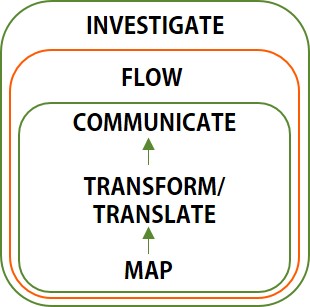This is my last blog in the series Key Components to B2B Integration (see below for links to previous posts in the series). Below is the graphic that I have used to represent the different components of B2B integration. The next topic is investigate.

Investigate encompasses all the data that is captured from all the prior processes - map, transform/translate, communicate and flow - that is used to do research, fix problems, and make business decisions. I split investigate into three sections - basic reporting (this is a bad name, but I couldn't come up with another one), error and exception notifications and reporting, and knowledge reporting.
Basic reporting is something all integration and transform/translate software solutions should have. These reports include trading partner lists, mapping detail, acknowledgement reports, and process definitions. This information would be useful for documentation, to train someone, or possibly when investigating a problem.
The next section is error and exception reporting. The ability to be notified of a problem rather than monitoring logs was a big push back when I was an EDI programmer. At that time, we had to create our own notification system. I worked at Owens Corning and we were using a mainframe translator. We created a system that would call and let you know if there was an error during processing. It was an electronically generated voice, and Brad and I called him Alfredo :)
Error notification has come a long way since that time, but if you are still using an older translator, you probably had to develop your own error notification system.
If you look at the IBM translation/transformation products I have been reviewing in this series - Gentran:Server, Gentran:Director Pro, B2B Integrator, Transformation Extender (ITX) and WebSphere Data Interchange (WDI) - their native error notification and reporting is pretty basic. Gentran:Server Windows and B2B Integrator are more robust than Gentran:Server UNIX, Gentran:Director Pro, ITX, and WDI when it comes to error processing. They both have the capability of sending emails with error messages or customizable notifications. For example, you could generate an email if a customer sends a purchase order total or product quantity over a certain amount.
The next section of investigate is knowledge reporting. This is what I think differentiates the integration solutions of today from the translators of yesterday. The integration solutions of today capture information that allows management to make business decisions and see trends. For example, knowledge reporting could tell you which customers that send their data electronically have the most dollar volume, which products are ordered the most frequently, or are we selling more to a particular customer this year than last.
With the exception of B2B Integrator, the other solutions mentioned above do not capture the level of detail or retain the data to be able to do knowledge reporting. B2B Integrator provides a dashboard with the ability to do queries based on pre-defined criteria. Enhanced reporting is available through frameworks, which several third parties have created as an add-on to B2B Integrator. Since B2B Integrator can be used as a gateway for many types of transactions from any source or to any destination, the data available has a broader scope than a traditional translator.
For those companies that want more robust data, but their system does not capture the data needed, there are third party solutions that are independent of an integration or translation package. The benefits to using this type of add-on is that if your company uses many different translators, the data can all be gathered in one place. In addition, changing translators does not require losing previous data. I'll discuss this topic in a future blog.
Links to previous posts in the series…


